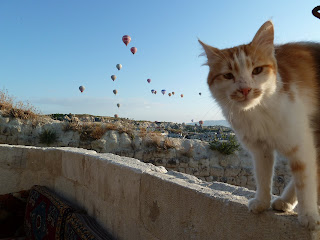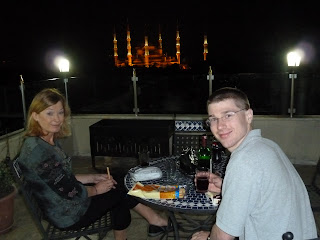From the moment you check in, this is clearly more than a hotel. Mustafa welcomes guests over fresh orange juice and homemade sweet bread in the breakfast room with its splendid view of the town's fairy chimeys. See that one over there? It belonged to his grandfather, the imam of the local mosque. Mustafa was born in Room#1 of the hotel and says he has a 30 minute story about each room. We stayed in #6, which used to be a grape storage room. The terrace has a splendid view. We're enouraged to take refreshments from the kitchen on the honor system. Mustafa -- and everyone who works for him -- wants you to feel at home. See more on the hotel's website, www.thecavehotel.com.
I booked this hotel after reading the rave reviews on Trip Advisor. Other guests, including a young doctor from Singapore, did the same. So have people from all over: Japanese, Australians, French. Some businesses here give out cards asking guests to review them on Trip Advisor. Not here. I asked Mustafa if he had a strategy for promoting his business through social networking. His answer was no. His only strategy is to deliver a quality product and hope the customers will rave about it. If you need a ride to a good hiking trail, they'll drop you off and pick you up at no charge. Want to see the best local sights in a small tour group? Mustafa suggests the local "Green Tour" which includes transportation, a guide, a memorable lunch in the Ihlara Valley and all admission fees to an underground city and a stone cathedral, quite a value at 70 Turkish lira per person.

After three days here, we are reluctant to leave. Mustafa is 51 and hopes to retire in a few years, leaving the business to his son Cem. Relatives and family friends seem well prepared to carry on his tradition of hospitality, but it will be hard to replace this master storyteller. Driving by a field of grapevines, we learn about the families who have passed down this land and divvied up the plots between the fairy chimneys. Cherry jam for breakfast? He tells you how his wife pressed the fruit with her own feet. He'll tell you about how their marriage was arranged when she was only 16 and he was 25. We were fortunate to arrive on the one day of the week when Mrs. Demirci cooks a homestyle Turkish meal for guests.
 Guests rave about this hotel because it offers both hospitality and history. I have just co-authored a book called "Power Performance: Multimedia Storytelling for Journalism and Public Relations, " and Chapter 6 discusses the importance of storytelling in public relations. That's why the Aydinli Cave House lives up to the promise on its brochure as "a hotel you won't forget." Mustafa has filled it with stories that guests can't wait to share.
Guests rave about this hotel because it offers both hospitality and history. I have just co-authored a book called "Power Performance: Multimedia Storytelling for Journalism and Public Relations, " and Chapter 6 discusses the importance of storytelling in public relations. That's why the Aydinli Cave House lives up to the promise on its brochure as "a hotel you won't forget." Mustafa has filled it with stories that guests can't wait to share.


























